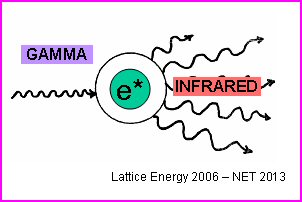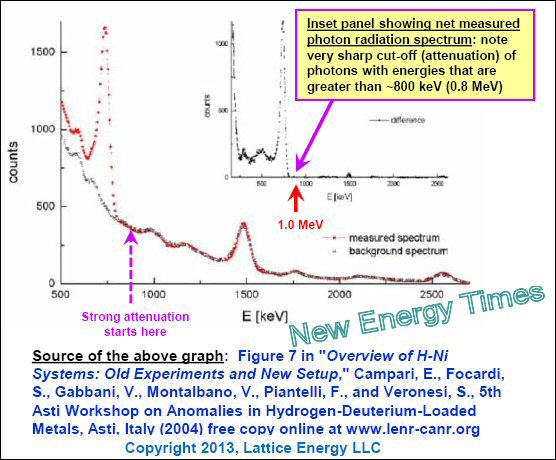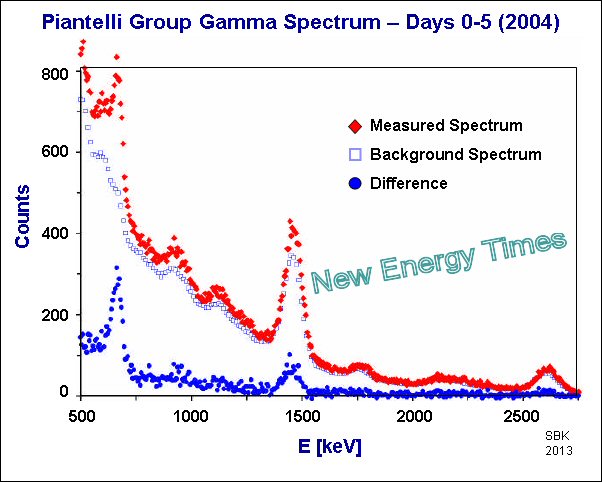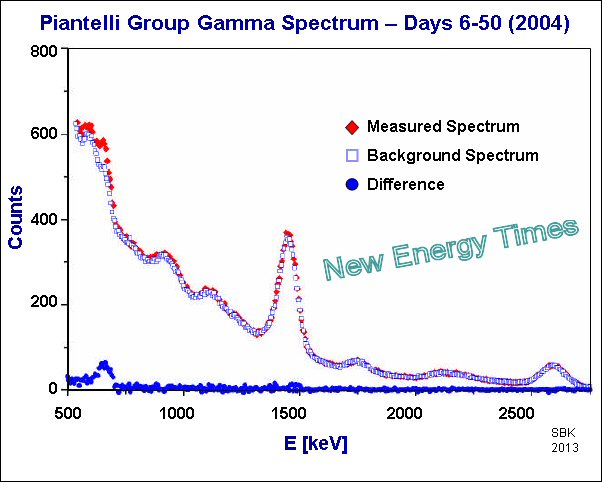Larsen Explains LENR Radiation-Free Nuclear Energy
 April 2, 2013 – By Steven B. Krivit –
April 2, 2013 – By Steven B. Krivit –
The possibility of a new source of radiation-free nuclear energy has just become stronger.
Lewis G. Larsen, the co-developer of the Widom-Larsen theory of LENRs, released a new slide presentation on March 22 that answers significant questions about why deadly gamma radiation is not emitted in low-energy nuclear reactions. New Energy Times spoke with Larsen about the examples of experimental evidence for the gamma suppression he shows in his slides.
Any kind of fusion or neutron-capture reaction that produces significant heat should emit enough gamma radiation to kill anyone in its vicinity. Throughout the history of this field, critics have wondered, If it’s really nuclear, then where are the gammas?
Going back to 1989, one of the most well-known physicists in the world, Richard Garwin, a senior scientist with IBM, was the first prominent critic to bet against what some people thought was “cold fusion.”
Garwin is an IBM Fellow Emeritus, was director of the IBM Watson Laboratory, director of applied research at the IBM Thomas J. Watson Research Center, and a member of the IBM corporate technical committee. He is also a consultant to the federal government on nuclear technology.
[DAP errMsgTemplate=”” isLoggedIn=”N”]
Login or Subscribe to remove this notice
Professional Journalism – LENR Facts
Original online content only at New Energy Times
[/DAP]
Six years ago, at the American Association for the Advancement of Science meeting in San Francisco, New Energy Times asked Garwin whether he had seen the Widom-Larsen theory papers. He had. But Garwin seemed frustrated because Larsen had not disclosed details of the gamma-shielding process when Garwin asked a question about it.
Larsen told New Energy Times on March 26, 2013, why he delayed responding to Garwin’s question.
“I have the highest regard for Garwin’s reputation as a brilliant physicist, but IBM files more patents than any other company in the world,” Larsen said. “Our patent application hadn’t even published yet. Why would a tiny company in Chicago like mine want to take that kind of risk when they have the financial resources to quickly file hundreds of patents on LENRs? That would’ve been foolish on our part.”
Larsen later disclosed the key details in his U.S. patent #7,893,414 B2, which issued on Feb. 22, 2011. Over the years, other people asked more questions about the gamma-shielding mechanism, and Larsen gave those answers last week in his slides.
Two paragraphs in his slides contain the key text that explains the gamma suppression for prompt gammas. It is excerpted below and slightly edited for clarity.
[DAP errMsgTemplate=”” isLoggedIn=”Y”]
“When an ultra-low-momentum neutron captures onto an atom located inside the entangled three-dimensional quantum-mechanical structure of a LENR-active patch, there is normally a prompt gamma photon emission by that atom. The key point to remember is that the DeBroglie wave functions of the entangled, mass-renormalized ‘heavy’ electrons are also three-dimensional, not two-dimensional. [The surface of a metal hydride is not two-dimensional; it has some depth.]
“Because the neutron-capture gamma photon emission occurs within the structure of a LENR-active patch, there are always heavy electrons available nearby to absorb such gamma emissions and convert them directly into infrared photons. Therefore, it doesn’t matter where a gamma emission occurs inside a given patch, it will always get converted to infrared, which is exactly what has been observed experimentally. Large fluxes of ‘hard’ gammas will not be emitted from such a patch, no matter which direction, on any axis, they are measured from.”
The next paragraph explains the gamma suppression that occurs with beta-delayed gammas that can occur in the reactions.
In his slides, Larsen discusses an experiment performed by the Francesco Piantelli group in the 1990s. One of the group’s key experiments ran for many weeks and produced significant excess heat. According to the Widom-Larsen theory, gamma emissions above 0.5 to 1.0 MeV are suppressed.
In the larger graph below, the black line shows the background gamma counts, and the red line shows the measured gamma counts from the experiment. Background gamma counts go out to 2,500 in a slowly decreasing curve. But the counts taken while the experiment was running, shown more clearly in the inset panel, drop to background levels abruptly at 800 keV.

Larsen’s Annotation of Piantelli Gamma Cutoff
After the experiment has run for five days, two small gamma peaks are visible, one at about 600 keV and another just below 1,500 keV.

Piantelli Group Gamma Spectrum Days 0-5
But after taking the mean of 18 acquisitions during the period from day 6 to day 50, two remarkable things appear. The peak at 600 keV drops from 300 counts to 50. The peak at 1500 keV disappears. No gamma radiation is seen beyond the small peak at 600 keV during this time. This is particularly significant because neutron captures on nickel isotopes normally produce gamma emissions in the MeV range.

Piantelli Group Gamma Spectrum Days 6-50
“This is a direct experimental observation of the suppression of gammas via conversion to infrared by heavy electrons per our theory,” Larsen said. “After 600 keV, the gamma emissions drop off drastically, right on the edge of the cutoff region around 500 to 1000 keV that we predict. All gamma emissions with higher energy than this region drop to background and stay there through the duration of the experiment. Our theory predicts that the suppression also extends up to between 10 and 11 MeV. There are only a handful of other neutron captures, out of thousands, that are more energetic than 11 MeV.”
The Piantelli group wrote that, after day 50, the entire gamma spectrum went completely to background and stayed at that level while the experiment continued for another 35 days, during which it produced 25 MJ of heat.
“After this time period,” the group wrote, “the spectrum went abruptly to the background one. Later on, the cell produced excess power, maximum 25 W measured with the method reported in Ref. 2, for about 35 days, after which the cell was shut down, in order to repeat the experiment.”
In the history of the field, intermittent, low levels of gamma radiation have been reported often. Until now, there was never any logical explanation. In Larsen’s slide #25, he provides additional details of three key phases that occur during the experiment.
“This is an example of an experiment that produced a huge amount of heat,” Larsen said. “Initially, you don’t have a large population of heavy electrons. But once you start making them, which are required to start making the heat, the gamma is cut off; you get the heat but no gammas.”
“Some people are thinking the gamma shield is something that is covering the whole surface. This isn’t necessary, and this isn’t what happens. All you need to do is have the shield at the LENR-active sites. It’s intrinsic to the system; the LENR-active sites have their own built-in gamma shield.”
The gamma conversion to infrared also helps to explain the LENR experiments that have shown the ability to be self-sustaining for brief periods. Larsen explains that the Piantelli experiment is an example of a resonant electromagnetic cavity in which the infrared radiation causes positive thermal feedback as the experiments get hotter.
“The only reason it works at all is that the gammas are converted into infrared, and the walls re-radiate it back into the active area of the experiment.” Larsen said. “If they didn’t convert, the gammas would go right through the stainless steel walls and escape, and they would cool the system.”
According to Larsen, the Piantelli experiment provides an easy way to understand the natural ability of LENRs to self-sustain. For the system to start, it needs the addition of enough energy to create the first neutrons. The Piantelli design does this with an electric heater. Once the system gets going, it starts emitting electromagnetic radiation in the form of infrared heat. It reflects back from the stainless steel walls and feeds the production of the neutrons. Once the cycle starts, because the net energy gain is positive, the system doesn’t need the electric heater, and it runs until the fuel is consumed.
Larsen performed a simple calculation based on one proposed nucleosynthetic pathway predicting that this type of experiment should produce an eightfold gain of energy.
Questions? Comments? Submit a Letter to the Editor.

